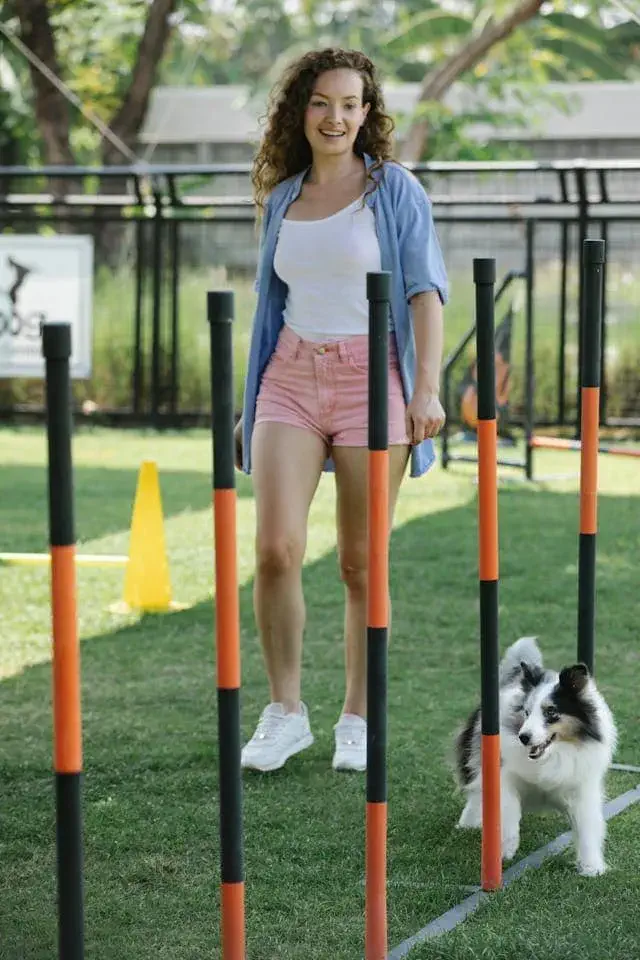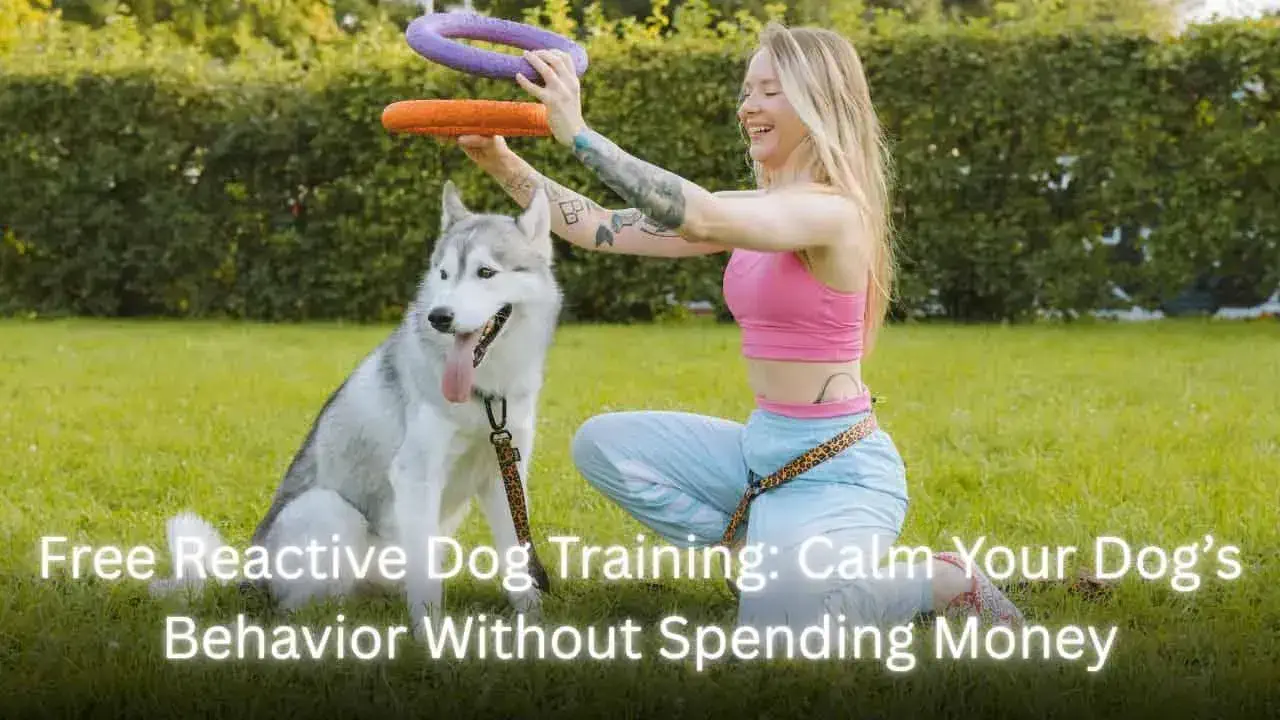Does your dog bark, lunge, or overreact when seeing other dogs or strangers? You may be dealing with a reactive dog. Reactivity can make daily walks stressful and confusing for both pets and owners. The good news is, you don’t need expensive trainers to fix it — effective results are possible with free reactive dog training methods.
Table of Contents
Using patience, positive reinforcement, and simple home techniques, you can help your dog stay calm and confident in any situation. Let’s explore how to start your free reactive dog training journey today.
What Is Reactive Dog Training?

Reactive dog training is a method used to help dogs who overreact to certain triggers such as other dogs, strangers, noises, or moving objects. A reactive dog isn’t necessarily aggressive — they often act out of fear, excitement, or frustration. The goal of free reactive dog training is to teach your dog how to stay calm and focused in these situations using positive reinforcement, patience, and consistency. Instead of punishing unwanted behavior, this training helps your dog build confidence and learn that triggers are not something to fear or react to.
Causes of Dog Reactivity

Understanding why your dog reacts strongly is the first step in successful free reactive dog training. Reactivity can develop from a mix of emotional, social, and environmental factors. Common causes include:
- Fear or Anxiety: Dogs who’ve had negative experiences may react defensively.
- Lack of Socialization: Limited exposure to people, dogs, or new environments can lead to overreactions.
- Past Trauma: Rescue or shelter dogs may associate certain triggers with bad memories.
- Overexcitement or Frustration: Some dogs simply get too eager and struggle to control their energy.
- Inconsistent Training: Without clear boundaries, dogs can become confused and reactive.
Identifying these causes helps you tailor free reactive dog training methods to your dog’s specific needs.
Benefits of Free Reactive Dog Training

Free reactive dog training offers many positive results for both dogs and owners — without the need for costly sessions. By using simple, consistent methods, you can help your dog feel more relaxed and confident every day.
Key benefits include:
- 🐾 Improved Behavior: Your dog learns to stay calm and respond positively around triggers.
- 💪 More Confidence: Regular training builds trust and emotional stability.
- ❤️ Stronger Bond: Working together deepens your connection and mutual understanding.
- 🌳 Stress-Free Walks: Walks become more enjoyable and peaceful.
- 💸 Cost Savings: You can achieve real progress using free online resources and at-home techniques.
With free reactive dog training, you’re not just saving money — you’re creating a calmer, happier life for your dog.
Step-by-Step Free Reactive Dog Training Techniques

You can start free reactive dog training at home with patience, consistency, and the right approach. These simple steps help your dog stay calm, focused, and confident around triggers.
Step 1: Identify Your Dog’s Triggers
Observe when and where your dog reacts — it could be other dogs, strangers, sounds, or vehicles. Knowing the cause helps you control the situation better.
Step 2: Maintain a Safe Distance
Keep your dog far enough from triggers so they stay calm. Gradually decrease the distance as your dog becomes more comfortable.
Step 3: Use Desensitization and Counterconditioning
Expose your dog to triggers slowly while rewarding calm behavior. Over time, they’ll associate triggers with positive experiences instead of stress.
Step 4: Teach Focus Commands
Train your dog to respond to cues like “look at me” or “focus.” This redirects attention away from the trigger and back to you.
Step 5: Reward Calm Behavior
Use treats, praise, or playtime when your dog stays calm. Positive reinforcement is key to effective free reactive dog training.
Step 6: Stay Consistent and Patient
Progress takes time — daily practice and a calm attitude will bring steady improvement.
By following these free techniques, you can transform your reactive dog’s behavior naturally and build lasting trust.

Free Resources for Reactive Dog Training

You don’t need to spend money to make progress — there are plenty of free reactive dog training resources available online and in your local community. These tools can guide you step-by-step while helping you stay consistent with positive training.
Here are some top free resources to explore:
- 🎥 YouTube Tutorials: Channels like Kikopup, Zak George’s Dog Training Revolution, and Dog Training by Kikopup offer detailed, free reactive dog training videos.
- 📘 Free eBooks and Blogs: Many dog behavior experts share guides, tips, and printable training plans online.
- 💬 Online Communities & Forums: Join Facebook groups or Reddit communities focused on reactive dog support — get advice from real owners and trainers.
- 🐶 Animal Shelters & Rescue Centers: Some local shelters host free training workshops or Q&A sessions.
- 📱 Free Dog Training Apps: Try apps that track progress and offer training games designed for reactivity and focus.
Using these free reactive dog training resources regularly can help you gain confidence and improve your dog’s behavior — without spending a cent.
Common Mistakes to Avoid

While free reactive dog training can be highly effective, some common mistakes can slow progress or make your dog’s behavior worse. Avoiding these errors will help you build trust and achieve better results.
1. Punishing Your Dog
Yelling, pulling the leash, or using punishment can increase fear and reactivity. Always use calm, positive reinforcement instead.
2. Moving Too Close Too Soon
Pushing your dog near triggers before they’re ready can cause setbacks. Take small steps and respect your dog’s comfort zone.
3. Ignoring Early Signs of Stress
Lip licking, yawning, or tense posture are warning signs. Notice them early and adjust the distance or environment.
4. Inconsistent Training
Skipping sessions or changing commands confuses your dog. Stay consistent with your free reactive dog training routine.
5. Expecting Quick Results
Reactive dog training takes time. Patience and repetition are key to long-term success.
By avoiding these mistakes, your free reactive dog training journey will be smoother, more positive, and far more rewarding for both you and your dog.
When to Seek Professional Help

While free reactive dog training methods can make a big difference, some dogs may need extra support from a certified professional. Knowing when to seek help ensures your dog’s safety and emotional well-being.
You should consider professional training if:
- Your dog shows aggressive behavior, such as growling, snapping, or biting.
- Reactivity remains unchanged after weeks of consistent free training.
- Your dog experiences severe fear, anxiety, or panic during walks.
- You feel overwhelmed or unsafe handling your dog’s reactions.
A certified dog behaviorist or positive reinforcement trainer can create a personalized plan tailored to your dog’s triggers and personality. Combining expert advice with free reactive dog training techniques at home often delivers the best long-term results.
Real-Life Success Stories

Many dog owners have transformed their pets’ behavior through patience, consistency, and free reactive dog training techniques. These real-life examples show that progress is possible without spending money on professional sessions.
🐾 Bella’s Story:
Bella, a rescue Border Collie, barked and lunged at every dog she saw. Her owner started daily short training sessions using focus commands and rewards. Within two months, Bella began walking calmly around other dogs.
🐕 Max’s Story:
Max, a Labrador mix, reacted to loud noises and strangers. His owner followed free online tutorials and practiced desensitization with treats. Over time, Max learned to stay relaxed and confident during walks.
🐶 Luna’s Story:
Luna’s family used consistent free reactive dog training from YouTube videos. With slow exposure and praise, Luna became more social and less fearful outdoors.
These success stories prove that with patience and free resources, you can help your reactive dog feel calm, happy, and secure again.
Conclusion
Reactive behavior can be challenging, but with patience, consistency, and the right guidance, every dog can improve. The best part is that you don’t need to spend money to make real progress — free reactive dog training methods work effectively when practiced with love and dedication.
By understanding your dog’s triggers, using positive reinforcement, and following simple daily steps, you can help your furry friend stay calm and confident. Start your free reactive dog training journey today and enjoy a stronger bond with a happier, more relaxed dog.
FAQs
What are some free techniques for training a reactive dog?
Desensitization and counterconditioning (gradual exposure to triggers).
Focus commands like “look at me” or “watch me.”
Reward calm behavior with treats or praise.
Distance management (keeping safe space from triggers).
Consistent short training sessions at home.
Can you train a reactive dog for free?
Yes, using online tutorials, blogs, forums, and at-home techniques, you can effectively train a reactive dog without spending money.
How do you start training a reactive dog for free?
Identify your dog’s triggers.
Keep a safe distance from triggers.
Use positive reinforcement to reward calm behavior.
Practice short, consistent sessions daily.
Utilize free online resources for guidance.




